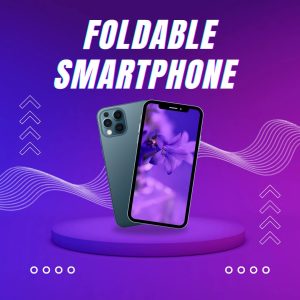The Rise of Foldable Smartphones: Innovation or Gimmick?
Introduction
The smartphone industry has always been driven by innovation, from touchscreens to bezel-less displays. However, one of the most controversial advancements in recent years is the rise of foldable smartphones. Companies like Samsung, Huawei, Motorola, and even Apple (with rumored developments) have invested heavily in this technology. But the question remains: Are foldable smartphones a revolutionary innovation or just an expensive gimmick to revive slowing smartphone sales?This article explores the evolution, benefits, drawbacks, and future of foldable smartphones to determine whether they are truly the next big thing or just a passing trend.

More Information here-Link
1. The Evolution of Foldable Smartphones
1.1 Early Concepts and Prototypes
- The idea of foldable displays dates back to science fiction and early tech prototypes.
- Companies like Nokia and LG experimented with bendable displays in the early 2010s but never commercialized them.
- Samsung’s first foldable concept was showcased in 2013, but technical limitations delayed its release.
1.2 The First Commercial Foldable Phones
- 2019: Samsung Galaxy Fold – The first mass-market foldable phone, despite initial durability issues.
- Huawei Mate X – A rival foldable with an outward-folding design.
- Motorola Razr (2019) – A nostalgic flip-phone revival with a foldable touchscreen.
1.3 Current Market Leaders
- Samsung dominates with the Galaxy Z Fold and Z Flip series.
- Google Pixel Fold (2023) – Google’s entry into the foldable market.
- Oppo, Xiaomi, and Vivo have also launched foldables, mainly in Asia.
2. How Do Foldable Smartphones Work?
2.1 Flexible Display Technology
- OLED panels are used because they can bend without breaking.
- Ultra-thin glass (UTG) is layered over the display for durability.
- Hinge mechanisms allow smooth folding without damaging the screen.
2.2 Software Adaptations
- Multi-window multitasking – Apps adjust when unfolded for a tablet-like experience.
- App continuity – Seamless transition between folded and unfolded modes.
3. The Innovation: Why Foldables Could Be the Future
3.1 Enhanced Multitasking and Productivity
- Larger screens allow split-screen apps, drag-and-drop features, and desktop-like workflows.
- Ideal for professionals who need a phone and tablet in one device.
3.2 Portability Meets Big-Screen Experience
- Folded: Compact like a traditional smartphone.
- Unfolded: Expands into a mini-tablet for media consumption.
3.3 Pushing Technological Boundaries
- Encourages advancements in flexible materials, battery efficiency, and software optimization.
- Could lead to rollable or stretchable displays in the future.
3.4 Reviving Consumer Interest
- With declining smartphone sales, foldables offer a new reason to upgrade.
- Attracts early adopters and tech enthusiasts looking for cutting-edge gadgets.
4. The Gimmick: Why Foldables Might Fail
4.1 Durability Concerns
- Early models suffered from screen creases, hinge failures, and dust damage.
- Even with improvements, long-term reliability remains questionable.
4.2 High Cost
- Foldables are significantly more expensive than flagship smartphones.
- Example: Samsung Galaxy Z Fold 5 (1,800)vs.iPhone15Pro(999).
4.3 Limited Practical Use Cases
- Many users don’t need a tablet-sized screen on a phone.
- Heavier and thicker than traditional smartphones when folded.
4.4 Niche Market Appeal
- Only tech enthusiasts and early adopters are buying them.
- Mainstream consumers still prefer traditional slab phones.
5. The Future of Foldable Smartphones
5.1 Potential Improvements
- Better durability – More resilient hinges and scratch-resistant screens.
- Lower prices – Economies of scale could make foldables more affordable.
- More app optimization – Developers need to adapt apps for foldable displays.
5.2 Competing Technologies
- Rollable phones (e.g., LG Rollable, TCL’s slide-out displays).
- Augmented Reality (AR) glasses – Could replace the need for larger screens.
5.3 Will Foldables Replace Traditional Smartphones?
- Unlikely in the short term due to cost and durability concerns.
- Possible in the long run if technology matures and prices drop.
6. Conclusion: Innovation or Gimmick?
Foldable smartphones represent an exciting leap in mobile technology, offering unique benefits in multitasking and portability. However, high costs, durability issues, and niche appeal prevent them from becoming mainstream—at least for now.
Final Verdict:
- Innovation? Yes, for early adopters and tech enthusiasts.
- Gimmick? For the average consumer, until prices drop and reliability improves.
The future of foldables depends on how quickly manufacturers can address current limitations. If they succeed, foldable smartphones could redefine the mobile industry. If not, they may remain a futuristic experiment that never truly takes off.
What Do You Think?
Are foldable smartphones worth the hype, or are they just a passing trend?










